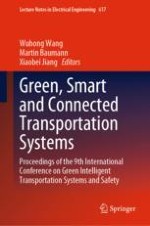2020 | OriginalPaper | Buchkapitel
Regression Tree Model of the Scale’s Dynamic Adjustment of Cruising Taxicab Capacity
verfasst von : Xiaofei Ye, Min Li, Xuan Li, Lili Lu, Yu-ming Jin
Erschienen in: Green, Smart and Connected Transportation Systems
Verlag: Springer Singapore
Aktivieren Sie unsere intelligente Suche, um passende Fachinhalte oder Patente zu finden.
Wählen Sie Textabschnitte aus um mit Künstlicher Intelligenz passenden Patente zu finden. powered by
Markieren Sie Textabschnitte, um KI-gestützt weitere passende Inhalte zu finden. powered by
